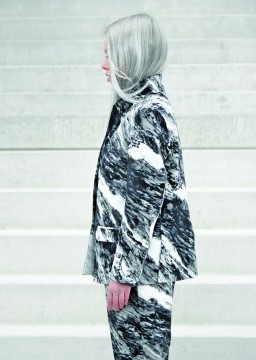Cracked, crinkled, crimped or creased, marbling in its most natural form and pattern can be combined with any interior, apparel or accessory for the ‘wow’ factor. Treated as one of the easiest methods of dyeing fabric, marbling imparts fluidity and creates abstract forms in the course of a normal dyeing process. Marble effect can go with almost any style and taste. Because of its design sensibilities it can be combined with other hot trends of the moment like metal and pastels, as well. These zigzag patterns are easily achievable with printing and batik techniques as well. Giving a new twist to ancient fabric dyeing, the effect of marbling gives a very water-colour, spilled and splatters effect. Witnessing the growth of marbling versions since the last three seasons, exporters and printing jobworkers have grabbed this opportunity to launch new and innovative adaptations meeting this interesting print trend…
Without a doubt, marbling is one of the fastest growing trends right now and if an expert’s comments are to be believed, marbling is going to become a hit in the S/S ’16 RTW collections. The technique has become increasingly popular over the last year and the hype doesn’t seem to slow down anytime soon. Being an interesting mix of classical and modern, this simple pattern is so versatile, that it can provide dynamism to products from any segment. Inder Mohan Bhambri, Director, Srigan Exports, explaining about the marbling effect said, “Garment dyeing has been an ongoing practice since years – both commercially and as a home procedure but now due to increasing demand of variant designs/techniques in the fashion industry, marbling technique is really picking up for the distinctive look that it gives to garments.”
Whether they are bold and crazy or subtle and sophisticated, marbling in variation of patterns are being created through rotary and digital printing. These swirly designs have been making a strong statement since the runways of S/S ’14, with designers such as Phillip Lim, Rachel Comey and Peter Som using it on items such as shirts, sweaters and dresses. Marbling is the process of floating fabric paints on the surface of a thick cellulose solution (called ‘size’), or oil on water. The floating paints are swirled into patterns, and this is how the pattern is captured. Due to this unique process, each pattern developed is unique in itself and helps create the sense of individuality.
The effect of marbling, amongst others, is manipulated the most by designers. With every technique moving towards digitalization and customisation, marbling can see a lot of innovations through varied printing techniques as well. Munesh Kumar, Proprietor, Kalka Filaments, manufacturer, exporter, supplier and wholesaler of printed leggings, stoles and scarves shares, “Nowadays, with increased design demands from clients, we incline more towards developing combination prints, and abstract marbling designs are the most attentiongauging ones. Be it colourful or black and white, smoky marbling effects are produced by dyeing or digital printing to achieve the desired look.” Marble is definitely having a moment of glory. With the rise of demand of marbling textures on kitchens, bathrooms and furniture, many designers and interior decorators are trying to mimic the natural marble textures on fabric also, translating the concept into lifestyle.
The main reason why the use of this technique has been intensified is because of the growing fashion trend towards abstract and iridescent patterning on casual clothing. Marbling is no longer restricted to provide only the base colour to the garment. Now, be it a plain or printed fabric, marbling techniques give an extremely unconventional look. Exporters of readymade garments, Sarc Original, whose whole manufacturing is all about over-dyed and tie & dyed fabrics, has been experimenting a lot lately in varied print techniques for their collection. M.K. Maheshwari, Partner of the company shared, “We do a lot of experimentations with printed and tie & dyed fabrics. Dresses are being given marbling effect on the top, projecting a batik kind of a look.”
Marbling is currently making a small shift to the digital platform. With the craze of this abstract design technique amplifying each day, it is a clever idea to shift the manufacturing process to a machine dependent one.
Marbling is no longer restricted to cottons, polyesters and other archetypical fabrics. Leather is a material which is getting manipulated a lot using marbling. Marbling effect using natural dyes makes the leather develop natural cracks which adds on to the cracking effect of marbling. Shahrukh Zaidi, MD, Studio SRZ, building further on this adds, “Classic leather pieces are taking on a rainbow of colours, including some very flashy shades, making them even more appealing, and marbling does an amazing job to add character to any piece. Techniques like marbling and wrinkle washing are being used to develop double coloured leather in jackets, skirts, etc.”
Marbling is currently making a small shift to the digital platform. With the craze of this abstract design technique amplifying each day, it is a clever idea to shift the manufacturing process to a machine dependent one. Immense amount of water is wasted during the manual marbling process and most of the time the water cannot be reused. And the oil or cellulose used in marbling also creates unnecessary wastage. Shifting the pattern creation to rotary or digital platform will reduce wastage and incline towards mass production. With high amount of resources being consumed in pre- and post-treatment, a printed option of the same would be more viable, especially in places where Government rules are becoming more stringent by the day. Deepak Vashisth, Owner, Dopulent Crafts, talking about the benefits of moving towards a machine platform said, “Though digital is also not commercially viable for bulk order in view of the cost and time factors, but it is able to deliver unique designs in multicolours not achievable through manual methods.”
With both designers and machine manufacturers looking at marbling as a future trend, new ideas to achieve the look, while maintaining individuality is going to be the way forward in various lifestyle products from garments to home.









